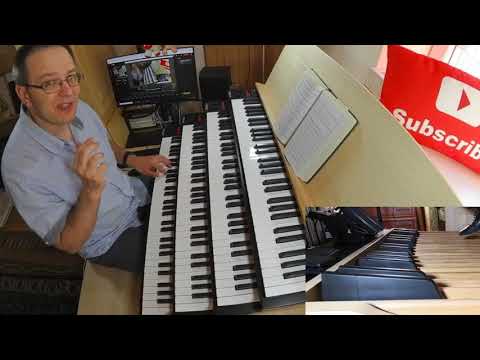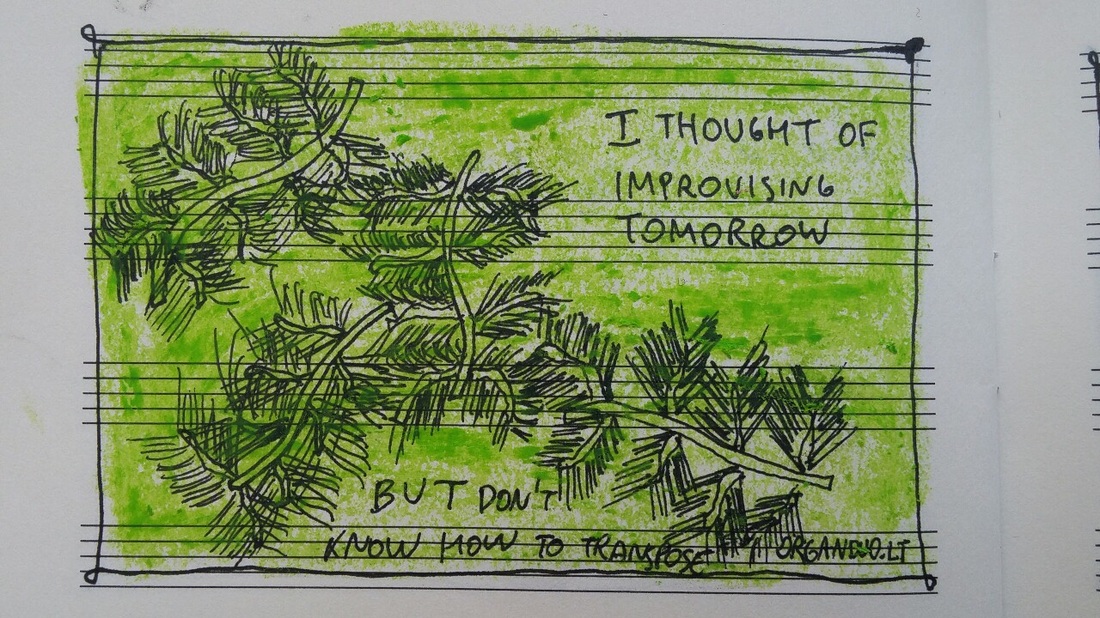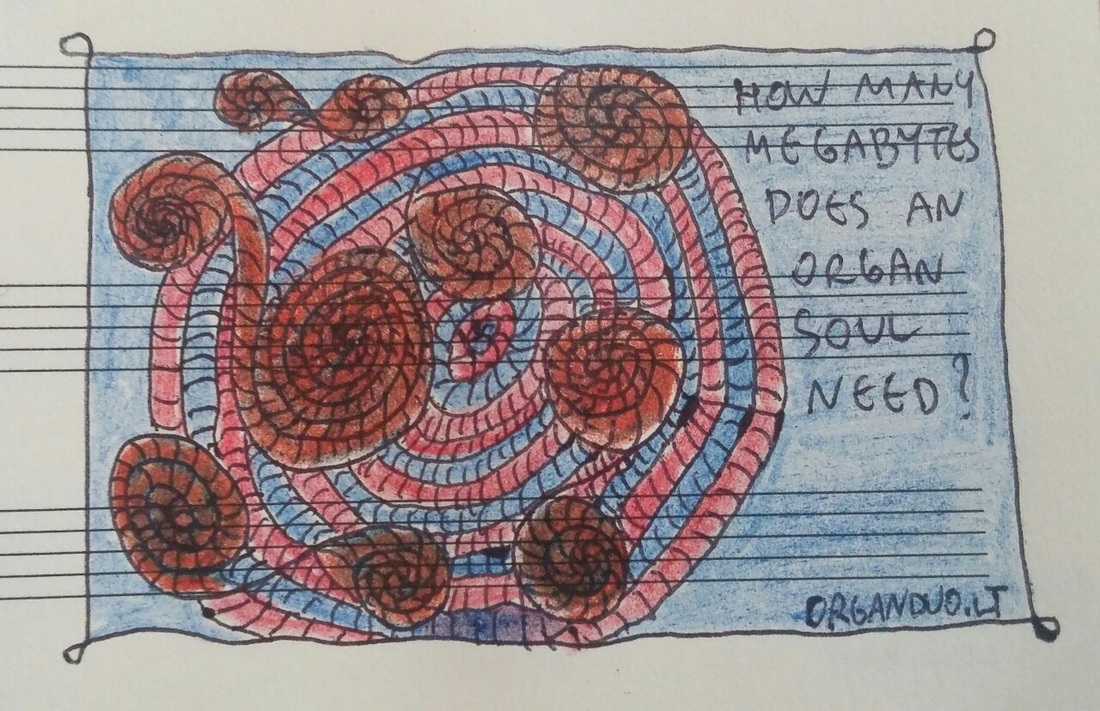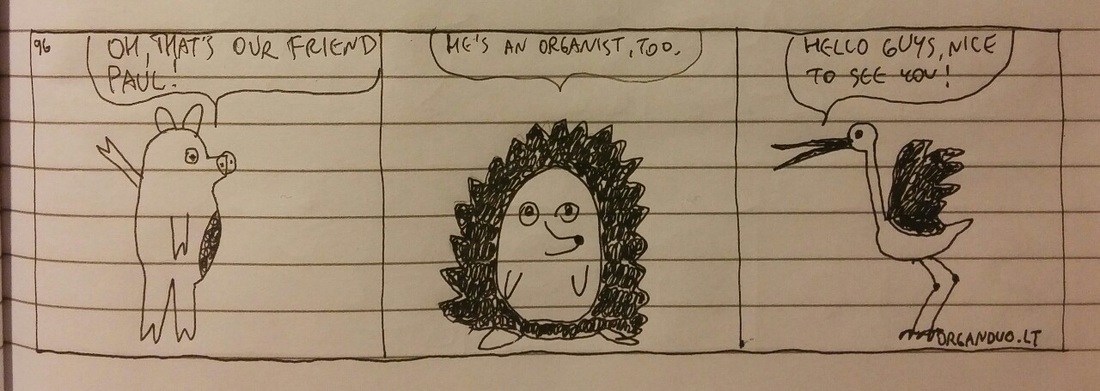|
Today I'm going to show you how to transpose a hymn from C major to A minor key. I will be playing on Velesovo sample set by Sonus Paradisi of Hauptwerk VPO.
Transposition for Organists (Level 1): https://secrets-of-organ-playing.mysh... Organ Verset Improvisation Master Course: https://secrets-of-organ-playing.mysh... Organ Hymn Improvisation (Level 1): https://secrets-of-organ-playing.mysh... Hymn Harmonization Workshop: https://secrets-of-organ-playing.mysh... If you like my music making, you can support me on Patreon and get free organ CD's at https://patreon.com/secretsoforganpla... Buy me coffee: https://www.paypal.me/VPinkevicius My Hauptwerk setup: https://www.organduo.lt/tools.html Total Organist - the most comprehensive organ training program online: https://www.organduo.lt/total-organist Secrets of Organ Playing - When You Practice, Miracles Happen! https://organduo.lt
Comments
AVA219: Would a given piece of music have the same "feel" if transposed to a different key?5/18/2018 Vidas: Hi guys, this is Vidas.
Ausra: And Ausra. Vidas: Let’s start Episode 219 of Ask Vidas and Ausra podcast. This question was sent in by Russell, and he writes: Greetings, Vidas. I found your course while searching for guidance as how to educate myself in music theory. I have a piano and an old Hammond organ, but I am not a musician. I read music, but only with difficulty. I desire to learn music theory because I do not understand many things about music. Most importantly, would a given piece of music have the same "feel" if transposed to a different key? For example, why did Bach choose D-minor for the Toccata & Fugue, BWV 565, and C-minor for the Passacaglia & Fugue, BWV 582? Would music written all in the same key be boring or tiresome? Or does the key (other than major or minor) enhance the effect of a particular piece of music? It seems to me that, for me, a good starting point would be to practice and memorize scales and chords. I love classical organ, but I wonder how an organist manages to keep track of multiple voices, such as in a fugue. I wonder whether some brains are "wired" with this capability and others are incapable of playing polyphonic music. By the way, are organists typically ambidextrous? At age seventy, I do not expect ever to become proficient on the organ, but I do find your instruction enlightening and welcome. Russell Harris V: Ausra, this is a nice account of Russell’s experience because at this age when he’s 70 years old and still is interested in music theory, it’s a great gift! A: Yes, you know, and I appreciate his question because some even professional musicians, they, you know, play for like 20, 30 years, and they never raise for themselves similar questions. So this is, I think, a very nice example of how people can, you know, think. V: Obviously, if pieces are written in different keys, there is a reason for that. A: Sure. And just a couple days ago Vidas and I gave a lecture at our school of art about historical temperaments. And, that’s why I think originally musical compositions were written in different keys, because each key had a different meaning, because each key sounded different at that time. Because before the beginning of the 20th century, you know, the A of the first octave wasn’t tuned in 440 Hz. V: Mhm A: And it could be higher. It could be lower, and the half steps wouldn’t be equal, and we have many many historical temperaments. And, in Bach’s time, for example, there were, like, Kirnberger II, Kirnberger III, and Werkmeister, and Rameau, and all those other temperament systems. So, and it makes sense why Bach wrote his compositions in different keys. Because each of it’s keys had its own unique character. V: And symbolism, too. A: Yes, that’s right. V: So, the difference between D minor and C minor was very apparent in those days---not so much in our time, if you play on a modern tuned instrument. A: True, because, you know, D minor was a more common key at that time, and it sounded a little more like a regular D minor key, especially because most of Baroque music still had like a D minor sort of Dorian feeling. V: Mhm A: It often had a raised 6th scale degree, not B♭ but B natural, as in the Dorian mode. V: Mhm A: But for example C minor, it had more accidentals, so it sounded more dramatic! V: Yes. The more accidentals you have, the more colorful the sound---sometimes dramatic, if it’s a minor key, and sometimes more joyful, I think, if it’s a major key. A: True! For example, E♭ major, that’s a very, very joyful character. V: Or A major. A: Yes. A major was suited more for, like, pastorale scenes. V: Mhm. A: And E♭ major was considered, because it has three accidentals, it was connected with the holy trinity. So, this is a whole different world beneath those keys. V: It’s connected with musical rhetoric, and musical affects theory, but Russell is, of course, on track here, thinking that it shouldn’t sound the same when transposed to a different key. And, he wants, of course, to learn more about music theory, and Russell suggests he would practice memorizing scales and chords. That’s probably one of the first steps, Ausra, right? A: Yes, I think it would be helpful. V: Not only will it improve his own technique, but his own knowledge of other keys, and the system of circle of fifths. Things like that will help him understand how pieces are put together. He should not stop here, though. Even if it’s a slow practice. But, I think in the not too distant future, he will be able to expand his knowledge into, let’s see, cadences, modulations, A: That’s right.. V: Things like that. And then the last part of his question is really intriguing. Russell asks whether some brains are wired for understanding and playing polyphonic music, and others not. A: <laughs> I think maybe for some people it maybe easier than for others, but, I think for everybody it’s quite hard and it needs some special training, and it needs time. V: But, for some people it’s easier than for others. A: That’s true! V: Who can coordinate and do two things at once. A: Well, and he asks about if the organists are typically ambidextrous. That’s a very nice question, actually. About that, that people can be ambidextrous, I found out about 10 years ago, only. Before that, I thought people could only be either right handed or left handed. But, you know, I am right handed, and so is Vidas! V: I even am right footed! A: <laughs> I don’t know about that, but, for myself, yes, I’m right handed, but since I have played starting from the age of five, in time, over the years, I think I improved my left hand enough. V: Mhm A: For example, in the summer time, sometimes I go to the forest to pick berries, for example, lingonberries or blueberries, and I can do that equally well with both hands. And other members of my family are wondering how I can do that so well, and I think its partly because I’ve played the instruments all my life: organ, piano, so… V: I also eat berries with both my hands! A: <laughs> but I’m telling you about picking them. V: Oh no, I prefer eating to picking! A: I know that, so that’s why I have to pick berries with both my hands, so that you could have plenty of them to eat! V: Yes, big stomach! And then, of course, we have to think about if some people develop this ability faster than others. What about, Ausra, your parents. Can they use their hands equally well or not? A: Well, probably not. V: Not so much. A: Not so much. Yes. And I think that it’s important, because you know that one part of the brain is responsible for math and science, and another one is for more responsible for arts V: Mhm A: and probably languages V: Creative stuff. A: Yes. So, and it’s important that if you are right handed that you would work more on your left side of the brain, and vice versa. V: To compensate? A: Yes. So I think for right handed, it’s a good way to learn arts. V: But actually, Ausra, you’re sort of… you have to add… because… it’s a mixed connection. The right side of the brain controls the left side of the body. A: Yes. V: Mostly. In motor skills. And vice versa. The right side of the brain controls the left hand, for example, more. A: That’s right. V: So, what does it mean? I think that you have to do both things at the same time sometimes. Improve both hands. To coordinate both hands. It’s wise to develop these skills especially in organ music because we have so many melodies moving independently at the same time. A: That’s true. And that’s why it’s so beneficial to play the organ, because it keeps your brain in a good shape. V: Yes. And, if Russell is 70 years old, he will find out for himself very soon that practicing actually organ music and analyzing organ music is even better than solving sudoku puzzles or crosswords from developing Alzheimer's to prevent such diseases, too. It’s like always engaging your brain, always exercising your brain when playing the organ. A: True! V: Wonderful. Thank you guys for listening to us and for applying our tips in your practice. We hope this has been helpful to you, and we also hope to receive more of your questions to help you grow further. This was Vidas, A: And Ausra. V: And remember, when you practice and share your art, A: Miracles happen. What's the first step, if you want to learn to improvise on the organ? Well, there are various approaches and in every case the organist has to deal with a lesser or greater degree of fear. A fear as in playing something which has never been played before. You don't know how it's going to start. You don't know how it's going to continue or end. Everything is risky. Every turn might end up in disaster. And this fear can be decreased or amplified if you restrict yourself with a certain technique you might want to use. You will hardly feel any fear, if you trust yourself in that technique, as in playing a hymn tune in two parts note against note very slowly in your practice room and the other part ONLY uses intervals of the thirds and sixths in alternation. But if you say to yourself, "Well, I wonder how I would do with 5 part double fugue when the entire congregation is listening?", you know how the fight will end up, don't you? One of the least amounts of fear involved is when you transpose. Think about it for a second. You have your hymn tune written out, as in hymnal and all you need to do is to play it minor or major second up or down. An approach which helps me a lot is to imagine or write out scale degrees of the new key on top of the soprano part of the hymn. Then you can just play those scale degrees in any key you want. Even in a different mode (minor, if the tune is in major, for example). That's all there is to it. Try experimenting with transposition and see if that helps to get over the fear of playing what is not written on the page and lead into the real world of improvisation. Has your church sold an old pipe organ which required money for repair which the church didn't have and bought a new electronic substitute? I feel sorry that your church didn't raise enough funds required for its keeping in the old place. Maybe the organist didn't earn enough trust of the congregation when there was a chance. Or maybe the congregation were the wrong people to earn trust from? Whatever the case, not enough people cared. Despite all those technical innovations digital organ lacks a soul and that's something you can't replace no matter how megabytes will go into it's memory for the sound of one pipe. Try to treat it as pipe organ though: Avoid artificial transposition and do that transposing yourself. Avoid using Manual Bass button as your foot technique will slowly decay. These skills will serve you well in the future when you will have an opportunity to play a real pipe organ somewhere else. [Thanks to David] Practice transposing the above excerpt from the Preludio, Op. 156, No. 1 by Joseph Rheinberger major 2nd upward to the key of D minor this way:
1. Right hand alone 2. Left hand alone 3. Pedals alone 4. Both hands together 5. Right hand and pedals together 6. Left hand and pedals together 7. All staves combined with both hands and pedals Take a slow tempo, aim for legato touch and 3 correct repetitions in a row in each step. Post time and the number of repetitions to comments. If you want to become a successful improviser, one of the most powerful tools is transposition. It helps to isolate ideas worth memorizing and make them your own. By transposing short fragments of your favorite pieces and cadences into as many keys as you can, you will be able to recollect them at a moment's notice, adapt to new situations, and use them in your improvisations in surprising ways.
Here are some of the strengths of transposition for the prospective improviser: 1. Transposition develops musical thinking. By forcing yourself to play a fragment in unfamiliar keys, you are creating a new musical universe which didn't exist before. Just as we can tell a story in our words, we too can create a musical story out of these musical elements. 2. Transposition improves your memory. In this case, we transpose from memory. Basically, we have to memorize a fragment in an original key and then try to recreate it in another key without looking at the score (except when we transpose by changing clefs and/or key signatures and looking at the score). 3. Transposition helps you to master any key you want. Don't use your key knowledge limitations as an excuse not to transpose. Don't say "I'm not good at playing with many sharps or flats." Simply master your fragment in a key without any accidentals (C major or A minor), then add just one sharp/flat (G major, E minor/F major, D minor). It's that simple. 4. Transposition develops your technique. Have you ever wished that your favorite composers created special exercises for you to practice? There you go - any fragment of any piece by any composer can become a potential exercise which will develop your finger and pedal technique and hand and feet independence. Have created something worth remembering yourself? Transpose that fragment and it will stay with you wherever you go. 5. Transposition helps you to master the styles of your favorite composers. Have you ever wished you could improvise a polyphony like Bach, choral ornamentation like Buxtehude, chromatic chords like Vierne, or colorful modes like Messiaen? Transpose their fragments and they will become your own. Although transposition is so powerful, it doesn't come with potential pitfalls: 1. Potential to transpose without thinking. This is especially evident in advanced keys. Your fingers guide your mind. Reverse this process by analyzing the chords first and directing your fingers with your mind. 2. Potential to make your improvisations lifeless. There is a tendency to play your fragment exactly as it is when you improvise. Do this frequently and your playing will lack the spark of unexpectedness or freshness. Instead, adapt and transform your fragments so that your listeners would never know where you are leading them. 3. Not all transpositions work in major/minor equally well. Sometimes this is due to the fact that chords that in major mode are minor, in minor mode become major and vice versa. Also some progressions and passages involve progression from 6th to 7th scale degrees. In harmonic minor this interval becomes augmented second which doesn't sound well (because of the 7th raised scale degree). Usually treating a fragment in melodic minor (raised 6th and 7th scale degrees) solves this problem. Still not convinced? You never know the true power of transposition, unless you try it. Grab a fragment of 1-4 measures, analyze and memorize it, and start transposing. And don't forget to share your experience with all of us. There are some very clear reasons why organists should learn to transpose. Among them - playing with vocalists and performing in a lower or a higher key to accommodate keyboard compass are most easily understood.
After all, if your vocalist is not feeling like singing in a higher key today, instead of choosing another piece, an organist could offer to transpose. Also if the range of the piece is rather broad and you maybe required to play a note which is not there on the keyboard, one option would be to transpose to a lower key. But here's another rather surprising reason to develop a skill to transpose music at sight: sometimes it's very handy when you play with instruments in an ensemble, too. Let me explain. Suppose you have a historical organ which is tuned in Chorton pitch (about half-step higher than normal - ca. 466 Hz.) and you have to play with early Baroque instrument ensemble (consort). Since you knew in advance that your organ is tuned to 466 Hz, your instrumentalists brought with them their instruments which were tuned to that pitch level, too. But when you get together for a rehearsal at the organ, you find out that because of the higher temperatures in the room (or maybe because of passing of the centuries), the organ pitch level rose to about 474 Hz. It's of almost no consequence to you, of course, but the instrumentalists, especially the wind instrument players, would be in a very bad situation. Since their instruments are tuned to 466 Hz, there is no way they could adjust to 474 Hz pitch that the organ has now - simply their mouthpieces wouldn't go in anymore to make the tuning higher. They would be very upset, of course. What to do? How could you save the concert? You could transpose your accompaniment (continuo) pieces one half-step lower which would make the organ sound too low (in comparison with the wind instruments). But now they could take out their mouthpieces a little and adjust to the sound of the organ. Usually there's more room to lower than to raise the pitch level of the wind instruments so that would be OK for them. I guess it's not the ideal scenario because playing on high pitch is different than playing on the lower pitch for them. Nevertheless, it's much better than nothing. So there you have it: learn a skill to transpose music at sight not only for yourself but also for the sake of other musicians who might perform together with you. By the way, this is one very practical reason that organs tuned in Chorton were more suited to accompany vocal and choir music back in the day while organs tuned in Kammerton (ca. 415 Hz - about half-step lower than normal) were meant to be used with chamber music ensembles. PS Some people who have just subscribed to the Total Organist program at the discounted rate seemed to have problems loging in to the member's area. For them the Member Login on the upper right corner of the homepage of this blog is not clicking. If this is the case for you, check, if your PC has Java installed. If you need Java, here is the link for free download and installation on your computer: https://java.com/en/download/index.jsp Old Hundredth tune is sung in many countries and in many languages. Therefore, it's not surprising that this lovely hymn is one of the most popular melodies sung in churches today. Surely every organist knows how to play it in G major or F major (the keys in which this hymn is the most easiest to sing for people). But have you tried to play it in 12 different major keys?
In this video, I demonstrate how this hymn harmonization sounds in all major keys. This could be a great exercise in hymn transposition which you might enjoy playing yourself. Today I would like you to transpose Bach's Aria, BWV 515 from the Notebook of Anna Magdalena Bach to various minor keys.
Here is the PDF score for this exercise. In this score you will only see the rhythms and the scale degrees of the melodies for the right hand and the left hand parts. If the note goes down, there is a sign V next to the scale degree. If the note goes up, there is an inverted V sign next to the scale degree. If the scale degree is repeated, there is a sign = next to the scale degree. If the scale degree is raised or lowered, there are + and - next to the number respectively. Here is the order of keys I recommend you practice this piece in: 1. A minor 2. E minor 3. D minor 4. B minor 5. G minor 6. F# minor 7. C minor 8. C# minor 9. F minor 10. G# minor 11. Bb minor 12. D# minor 13. Eb minor 14. A# minor 15. Ab minor If this exercise seems too complex for you, start with A minor and choose only a few simple keys for practice. Take a really slow tempo and practice single parts first before playing with both hands together. Don't worry, if the process is really slow - transposition extremely beneficial for your brain and your fingers alike. Please let me know how this exercise worked for you. One of my students from Organ Sight-Reading Master Course wrote to me that he has trouble playing exercises in the keys with 6 sharps and 6 flats (and probably with 5 or 7 accidentals as well). He plays everything very slowly (just as I recommend) but his frustration is very great.
He rightly pointed out that the reason why he has trouble with playing in advanced keys is that other than playing scales, he had very little experience with these keys. So the only practical advise that I could give to students like him is very simple - play as many pieces with lots of accidentals as you can find. Of course, simply picking the prelude and fugue with 6 sharps or flats from the Well-Tempered Clavier by Bach doesn't help very much. The music is too complex too begin with and you need a nice system in order to play in all the keys. It's best, if you could find a piece or an exercise already transposed to every key that exists in a logical order with ascending number of accidentals (0 accidentals, 1 sharp, 1 flat, 2 sharps, 2 flats, 3 sharps, 3 flats etc. until you reach the keys with 7 accidentals). In order to help him and other people who haven't had the experience with playing pieces with lots of keys signatures, today I have transposed a chorale harmonization of Wie schon leuchtet der Morgenstern to every single key of the major mode. I hope you will enjoy playing these transpositions not only because they will definitely help you in getting to know the keys with lots of accidentals better but also because this chorale is traditionally known as the chorale sung (and played) for Epiphany which is today. As always, in order to see the best results of your practice, I recommend playing each version of the transposition at least 3 times in a row correctly and fluently before advancing to the next one. A final thought: if you think that a special course with hymn settings like this one transposed in every key would be helpful to you, please let me know. |
DON'T MISS A THING! FREE UPDATES BY EMAIL.Thank you!You have successfully joined our subscriber list.  Photo by Edgaras Kurauskas Photo by Edgaras Kurauskas
Authors
Drs. Vidas Pinkevicius and Ausra Motuzaite-Pinkeviciene Organists of Vilnius University , creators of Secrets of Organ Playing. Our Hauptwerk Setup:
Categories
All
Archives
July 2024
|
This site participates in the Amazon, Thomann and other affiliate programs, the proceeds of which keep it free for anyone to read.
Copyright © 2011-2024 by Vidas Pinkevicius and Ausra Motuzaite-Pinkeviciene.
Terms of Service and Privacy Policy
Copyright © 2011-2024 by Vidas Pinkevicius and Ausra Motuzaite-Pinkeviciene.
Terms of Service and Privacy Policy










 RSS Feed
RSS Feed